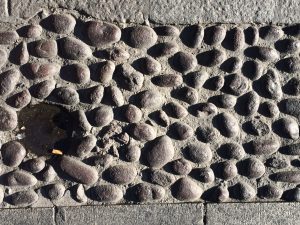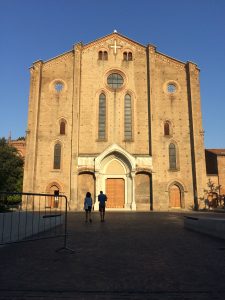It’s a torrid day in Bologna. From the neighbouring municipality of Casalecchio I followed the cycle-route that leads all the way to the city center. At the end of the renowned Via del Pratello, there is a public square called Piazza San Francesco, taking its name from the cathedral that dominates it.
It is August and the city is empty, pouring itself out on the mountains or at the seaside, seeking to escape from the humid heat that makes the still air almost unbreathable. In this period, any smell secreted by the streets or spilling out from shops and private houses is enhanced by the temperature and finds its way into the passengers’ nostrils. Cycling over the irregular stones of Via del Pratello’s ground is a confusing experience for the nose that is now stimulated by the scent of some delicious recipe and, immediately after, by the urine’s fumes, bequest of the previous night’s drinking attenders.
Cycling over the irregular stones of Via del Pratello’s ground is a confusing experience for the nose that is now stimulated by the scent of some delicious recipe and, immediately after, by the urine’s fumes, bequest of the previous night’s drinking attenders.
I crossed via del Pratello quite fastly as the gaze of people sitting at the bars makes me feel uncomfortable. The presence of bars with outside seats right on the road exposes those who transit to the curious eyes of those who sit and I feel i need to justify my presence in the space, for instance by pretending I’m waiting for someone. Cycling through Via del Pratello as fast as possible is a habit I developed when I was a kid, when my mom used to take me and my brother to the city center, ‘il centro‘, to have an ice cream and enjoy the many street performers who enlivened the Saturday afternoons with live music, mimicry and dance. I remember being a little kid, proud of my mountain bike but scared of riding it through the intimidating gutter punks and their massive dogs that were often in the area.
The last obstacle that separates me from the open space of Piazza San Francesco is a symbolic one and it exerts a magnetic repulsive force on me since when I was small. The juvenile hall, located half way into Via del Pratello, is perhaps more difficult to deal with than the nasty irregular road. I have often wondered who was detained in there and why. How different their life was from mine. Today I still struggle to stand in front of it and accept the violence it silently irradiates in the area. I remember of that one time, still in high school, we were taken to a theater play performed by some of the detainees. By the end of the show, I eavesdropped two penitentiary policemen who had come to take the actors back into their cells. While waiting for the end of the show and convinced of not being understood, they were whispering at each other in Neapolitan dialect some of the abuses they used to inflict to the actors on stage. They were giggling at that and I felt my blood freezing in my veins. Such episode reverberates through the outside walls of the jail every time I pass by it, still today
I remember of that one time, still in high school, we were taken to a theater play performed by some of the detainees. By the end of the show, I eavesdropped two penitentiary policemen who had come to take the actors back into their cells. While waiting for the end of the show and convinced of not being understood, they were whispering at each other in Neapolitan dialect some of the abuses they used to inflict to the actors on stage. They were giggling at that and I felt my blood freezing in my veins. Such episode reverberates through the outside walls of the jail every time I pass by it, still today
Getting to piazza San Francesco makes my journey more relaxed and easy in that it is a space where sitting and standing still feels more normal and could hardly be looked at with scrutiny.
 I feel very connected to this square, its atmosphere, the stones of its ground and the discreteness of its afternoon attenders. Here I celebrated my 18th birthday and countless are the evenings and nights I spent here with friends, lovers, strangers.
I feel very connected to this square, its atmosphere, the stones of its ground and the discreteness of its afternoon attenders. Here I celebrated my 18th birthday and countless are the evenings and nights I spent here with friends, lovers, strangers.

It is half past six: too early for it to be crowded and loud. However, the usual nocturnal liveliness of the square has been completely shut down through a temporary mayoral decree in order to prevent the transmission of Covid-19. While this is presented as a temporary and exceptional intervention, to me it looks seamlessly connected to the myriad of previous temporary decrees – gradually become permanent – aimed at harnessing and repressing the social life of the youth. Even though I can deconstruct the exceptionalism of such measure I am still curious, almost in a fetishistic way, about how the closing of the square is practically enforced.
One hour from the closing of the square some 30 people sit on its benches, only a handful on the small grass patches on one side. They are mostly small groups chatting gently, offering a calm and peaceful atmosphere to passengers and new attenders One street vendor, simply equipped with a small plastic bag in order not to attract the police attention, asks me with a wave whether I need anything. At night the square is usually taken over by 2 main groups of street vendors who sell respectively cold beer and articles for hand rolling, phone chargers, speakers and other small electronic devices. I wonder where and whether they are working now that the square and its night life – their workplace – are being physically locked up.
It feels weird to be sitting in a public space dealing with the awareness that shortly someone with a uniform will come and, in the name of public safety, force me (as well as others) to leave. It cruelly imposes on me a sense of distance from a place that I feel seamlessly connected to. This place is a part of me as much as I am a part of this place. Yet a public authority can tear apart such linkage by the means of a crush barriers and the law. Physically removing people from a place. Even pigeons will probably leave as the absence of human makes the square quite uninteresting for them too.
Interestingly, 30 minutes after the time of the square’s curfew people are still at their place, surrounded by barriers but carrying on with their activities undisturbed. No one has shown up to disrupt them. Yet. I left with a growing curiosity about the practicality of the curfew. Somehow I am protecting myself from the sight of what I really did not want to see. It might have happened few seconds after I left but it might also have not happened at all. I will find out, or maybe not.
